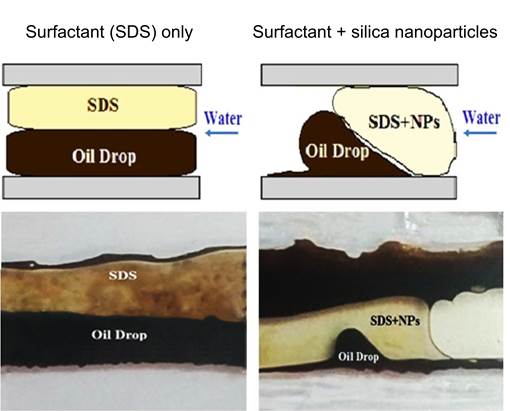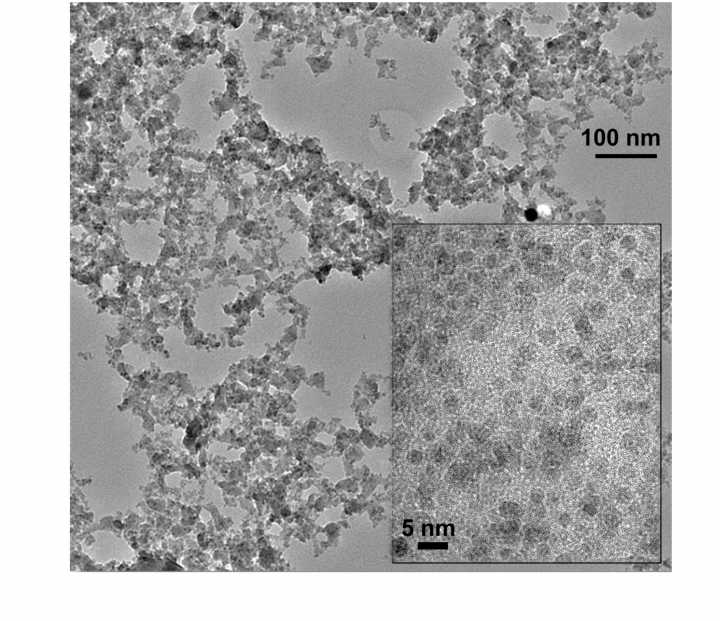
A new class of materials which are suitable agents for oil displacing in enhanced oil recovery have been developed by scientists in the Energy Safety Research Institute (ESRI) at Swansea University and scientists at Islamic Azad University in Iran.
The new nanoparticle-surfactant complexes, composed of sodium dodecyl sulfate (SDS) surfactant and fumed silica nanoparticles (Si-NPs) have important applications in enhanced oil recovery (EOR). The materials are shown to improve the oil recovery by 58% compared to 45% recovery in the presence of surfactant alone.
The researchers led by Goshtasp Cheraghian and Professor Andrew R. Barron reported their find in the American Chemical Society journal Industrial & Engineering Chemistry Research (http://pubs.acs.org/doi/abs/10.1021/acs.iecr.7b01675).
Fabrication and testing of these materials were carried out by Goshtasp Cheraghian (Member of Young Researchers at Azad University) and Sajad Kiani, (a PhD student at the Energy Safety Research Institute at the Swansea University Bay Campus).
There, they used a 5-spot glass micromodel to evaluate the suitable agents for oil displacing in EOR. Such micromodel experiments have been used to investigate the mechanism of the fluid flow on porous mediums via flow visualization, pore space geometry, topology and heterogeneity effects, which are not possible to assess using traditional core-flood experiments.
“It is a surprise that the addition of silica nanoparticles, essentially nano-sand, to the surfactant solution leads to such a large ?ow modi?cation,” said Barron, “the changes are due to an alteration of the viscosity as well as effective wettability alteration, which effects the sweeping of the oil towards the recovery point.”
The results of this work support an improved insight into the role of NPs and surfactants in enhanced oil recovery and future use in EOR formulations. Barron described the multinational team as “a great example of international collaboration across boarders aimed at developing new materials for minimizing the impact of oil production through maximizing recovery.”
The Latest on: Enhanced oil recovery
[google_news title=”” keyword=”enhanced oil recovery” num_posts=”10″ blurb_length=”0″ show_thumb=”left”]- Metawells Oil & Gas Inc. Releases Current Updateson April 29, 2024 at 1:19 pm
HARRISON, NY, April 29, 2024 (GLOBE NEWSWIRE) -- via NewMediaWire – Metawells Oil & Gas Inc. (OTC Pink: KOSK) releases updates following ...
- Thousands of Abandoned Oil and Gas Wells Pollute the Texas Landscapeon April 29, 2024 at 8:00 am
For one West Texas rancher, the orphaned wells have become both a mission and an existential threat. Dressed in a dark plaid button down and jeans with a rodeo belt buckle, Schuyler Wight arrived in ...
- Demand For Oil And Gas Will Continue For Very Long Time: Minister Al Kaabion April 28, 2024 at 9:42 pm
Doha, Qatar: Minister of State for Energy Affairs, the President and CEO of QatarEnergy, H E Saad Sherida Al Kaabi, took part in the World Economic Forum's special meeting on global collaboration, ...
- EERC receives $11.6 million grant towards enhanced oil recovery researchon April 27, 2024 at 3:35 pm
Sen. John Hoeven, R-ND said the funds will enable the EERC to conduct 18 months of field and laboratory research to study the viability of EOR.
- Well Intervention Market to Reach USD 12.90 Billion by 2031 Driven by Growing Demand for Enhanced Oil Recovery Techniqueson April 25, 2024 at 5:00 pm
The Well Intervention market is poised for growth driven by several factors. Aging oil and gas fields require well intervention services to maintain wellbore integrity, optimize production flow, and ...
- UND's EERC awarded more than $11 million for oil recovery, carbon storage projectson April 24, 2024 at 5:39 pm
GRAND FORKS — The Energy and Environmental Research Center at the University of North Dakota has been awarded $11.6 million for research related to enhanced oil recovery and carbon capture. The ...
- UND's EERC awarded more than $11 million for oil recovery, carbon storage projectson April 24, 2024 at 5:00 pm
Apr. 24—GRAND FORKS — The Energy and Environmental Research Center at the University of North Dakota has been awarded $11.6 million for research related to enhanced oil recovery and carbon ...
- UND’s EERC awarded more than $11 million for oil recovery, carbon storage projectson April 24, 2024 at 9:30 am
GRAND FORKS — The Energy & Environmental Research Center at the University of North Dakota has been awarded $11.6 million for research related to enhanced oil recovery and carbon capture.
- Millions going to UND to study enhanced oil recovery in the Bakkenon April 23, 2024 at 5:00 pm
State officials have said the practice -- known as enhanced oil recovery or EOR -- will be necessary to maintain high oil production past the 2030s. Much of the oil stuck underground is considered ...
- Specialty Oilfield Chemicals Market to Reach USD 14.06 Billion by 2031, Fueled by Rising Crude Oil Production and Enhanced Oil Recoveryon April 17, 2024 at 5:00 pm
Rising crude oil demand and the growing adoption of enhanced oil recovery techniques are fueling the specialty oilfield chemicals market growth According to the SNS Insider report, the specialty ...
via Google News and Bing News










